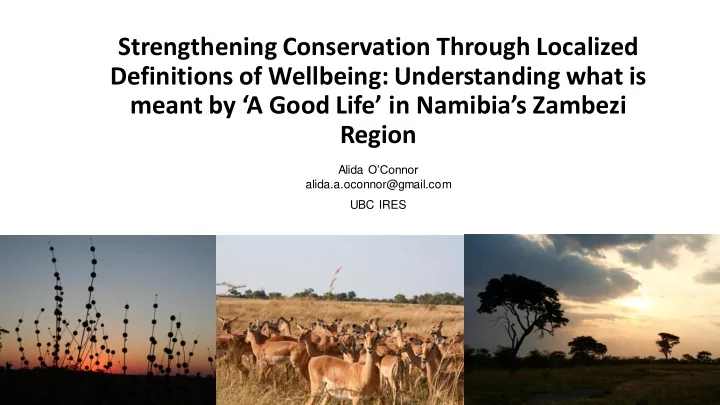

Strengthening Conservation Through Localized Definitions of Wellbeing: Understanding what is meant by ‘A Good Life’ in Namibia’s Zambezi Region Alida O’Connor alida.a.oconnor@gmail.com UBC IRES
1 What is eff ffective conservation? A shift from… • Fences and Fines: Conservation achieved in isolation from people to • Community-based conservation: Conservation that engages local communities Context Objectives Methods Findings Conclusions
2 Commu mmunity-Bas ased Conservation 2004 2010 Context Objectives Methods Findings Conclusions
3 What is Wellbeing? • Wellbeing measures must include economic AND social, cultural, environmental and political concerns • Most indices are created for national and international scale comparisons Can these broad categorizations of wellbeing represent local realities? Retrieved from OECD Context Objectives Methods Findings Conclusions
4 Tak akeaways from m the Literature 1. Conservation should include local people, as people are embedded in larger socio-ecological systems 2. Community based conservation has tried to do this, but has not been as successful as anticipated 3. Understanding wellbeing could help address this gap, but needs to be understood at the local level Context Objectives Methods Findings Conclusions
5 Case Study: Namibia’s conservan ancy progr gram amme • Has grown from 4 conservancies in 1998 to 83 conservancies today • Elephant and Rhino population has tripled • Growing lion population outside of national parks Retrieved from www.nacso.org Context Objectives Methods Findings Conclusions
6 Objectives 1. How is wellbeing defined by community members living within Namibia’s conservancies? • How are the conservancies impacting wellbeing? 2. Create a wellbeing monitoring tool for the WWF • Replicable • Easy for a committee member to use Context Objectives Methods Findings Conclusions
7 Site Selection: : Zamb ambezi zi Regi gion Context Objectives Methods Findings Conclusions
8 Interviews & Focus Groups Game Guards and Committee Members Mashi Conservancy Focus Group Context Objectives Methods Findings Conclusions
9 Results: : Wellbeing Defined Local ally Wellbeing Dimensions 1. Health: proximity to clinic 2. Water : near and safe water source 3. Information and News : staying connected 4. Education : possibility of new and different futures 5. Natural Resources : small scale security 6. Family: supporting kin 7. Agriculture : a way of life 8. Employment: alternate incomes 9. Wildlife: as wealth and wonder 10. Community: cohesion and cooperation Context Objectives Methods Findings Conclusions
10 Water: : nea near an and d saf afe e wat water er sou ource rce “We have a lot of elephants, hippos, and crocodiles here. We are not having a better life here through water [living by the river ].” (Mashi Conservancy Interview) “It’s good to stay very far from the river because we get water from the borehole. If we swim, or wash in the river, or bathe in the river, it’s not safe.” (Sachona Focus Group, Mashi Conservancy) Context Objectives Methods Findings Conclusions
11 Wildlife: : as as weal wealth an and d won wonder der “Our family, they got employment with the conservancy, so we are happy about that. And also we get the benefits , like money they give us at the end of the year. And also the meat. All those things. Also they give money to our schools and our churches. So we rely on the conservancy.” (Sachona Focus Group, Mashi Conservancy) Context Objectives Methods Findings Conclusions
12 Wildlife: : as as weal wealth an and d won wonder der “We are taking care of the wild animals for the future generations . For them to know them, to know this is a zebra. I don’t want to have to travel other places to see the Zebra. Wildlife is for the future generation also, to use as a resource.” (Lubuta Focus Group, Mashi Conservancy) Context Objectives Methods Findings Conclusions
13 Key Tak akeaways • Wellbeing dimensions must be interpreted locally • Local definitions must be incorporated in conservation planning and ongoing monitoring and evaluation Context Objectives Methods Findings Conclusions
14 Wellbeing Tool Context Objectives Methods Findings Conclusions
15 Context Objectives Methods Findings Conclusions
16 Imp mplications fo for the Future • Conservation initiatives that are better tailored to local needs can foster more meaningful community involvement • 60% of the world’s poor will live in rural areas by 2025, depending on the natural resources around them Context Objectives Methods Findings Conclusions
Acknowledgements Dr. Terre Satterfield, Dr. Milind Kandlikar, Dr. Robin Naidoo Obicious Siyanga& Eben Interview & Focus Group Participants WWF & IRDNC CCL Conference
Recommend
More recommend